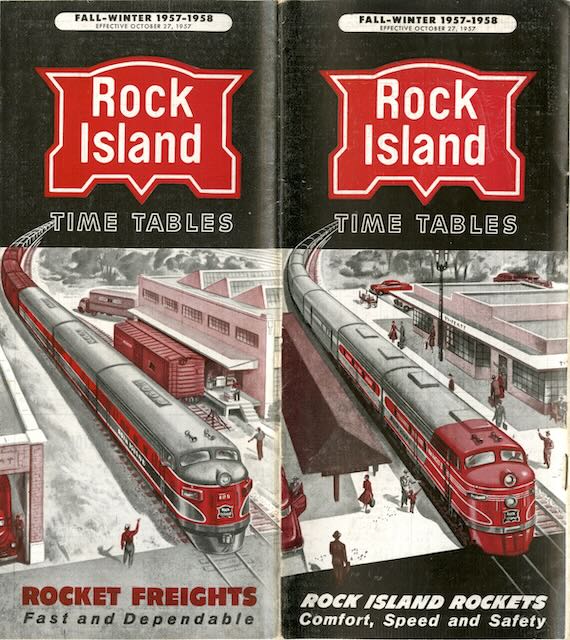Rock Island timetables stunningly shrank from 36 to 20 pages in 1957. We’ve previously seen a 36-page timetable from November 1956 and a 20-page timetable from May 1957. If there were any timetables between these two, they were probably also just 20 pages.
 Click image to download an 10.8-MB PDF of this 20-page timetable.
Click image to download an 10.8-MB PDF of this 20-page timetable.
The full-page ads on the front cover and inside back cover both disappeared along with two pages of interior ads. The centerfold map was reduced to fit on one page and moved to page 5. The station index and list of train equipment were both reduced from two pages to one and the little pictures of sleeping car accommodations, which took two pages in the 36-page versions, were completely eliminated from the 20-page editions. The condensed version of timetables shown near the beginning of the booklets were reduced from four pages to two.
All of that accounts for eleven of the missing pages. The twelfth page that disappeared in 1957 was one titled “Illinois Lines” that showed Chicago-Joliet and Chicago-Peoria trains. Those trains didn’t disappear, it’s just that this table was redundant with other tables in the booklet.
Another change in the 1957 timetables was the rotation of certain schedules. In 1956 and earlier, the schedules for the Golden State, Rocky Mountain, and Mid-Continent routes all filled two pages and were rotated 90 degrees so that readers could see the entire schedules of trains on these routes in one continuous column. The 1957 timetable keeps these pages at the same orientation as the rest of the timetable. Personally I prefer the consistent orientation, but I can see how it might be easier to read an entire table in one column.
The one significant change to the schedules is that the Minneapolis-Fort Worth Texas Rocket‘s name has been changed to Kansas City Rocket. The train retains its name both north and south of Kansas City, but that’s misleading because it was actually three different trains with no through cars.
From Minneapolis to Kansas City the train consisted of coaches, sleeping cars, and a lounge car. At Kansas City, through passengers had to change to another train consisting of coaches and a diner-lounge. At Enid, Oklahoma, through passengers had to change once again to a Rail Diesel Car.
Rock Island was still making profits in the 1950s. But the number of passengers must have been declining and the railroad appears to have decided that fat timetables cost more than they were worth.
